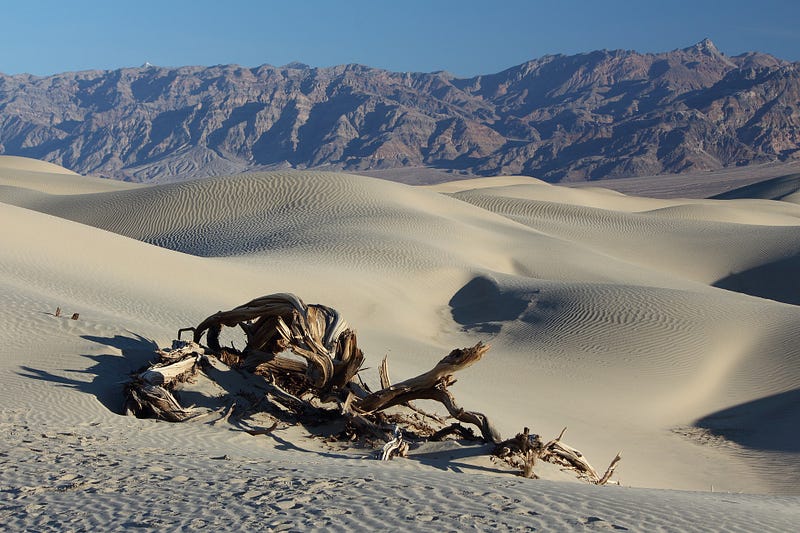# The Five Catastrophic Extinction Events in Earth's History
Written on
Chapter 1: Understanding Extinction Events
What does it mean for the world to end? Is it marked by explosions or raging fires? While we can't know for certain how the planet appeared when the age of dinosaurs concluded, we can imagine it was a chilling moment in Earth's long narrative. Although dinosaurs are often seen as the quintessential symbol of extinction, their story is just one of many in Earth's extensive timeline. Our planet has experienced five significant extinction events, each with its own unique cast of life forms and dramatic conclusions. As each era ended, the surviving inhabitants likely felt they were witnessing their own apocalypse.
This discussion will delve into the five mass extinctions that have dramatically transformed our planet. Notably, apart from the cataclysm that led to the dinosaurs' demise—the meteor impact—most of these disasters originated from Earth itself. It is perhaps these four homegrown catastrophes that could offer humanity the most valuable lessons.
Section 1.1: The First Extinction Event
444 million years ago, 86% of species vanished.
Imagine Earth 444 million years ago, a time difficult for us to grasp. To put this in perspective, if we compressed Earth's 4.5 billion-year history into a single year, humans would arrive just moments before the year ends on December 31st at 23:36. Significant milestones include the emergence of life on February 25, the development of photosynthesis on March 21, and the first nucleus-containing cell appearing on July 15.
However, the first mass extinction occurs on November 25, as sea levels drop due to a severe ice age. Complex life is predominantly found in the oceans, consisting mainly of simple organisms like pond scum, sponges, and bizarre sea creatures. The jawless fish emerges as a notable new species, while formidable ocean predators like the sea scorpion and the Cameroceras roam the waters.
As glaciers form, marine life is left stranded on barren shores, and toxic conditions develop in the oceans due to decreased carbon dioxide levels, leading to widespread extinction.
Section 1.2: The Second Extinction Event
375 million years ago, 75% of species were lost.
Survivors of this event include resilient trilobites, which thrive due to their tough armor and keen eyesight. The jawless fish persists, but new fish species with jaws and backbones emerge. This extinction is associated with the rise of land plants that stir up nutrients, resulting in algal blooms that consume oxygen and block sunlight, suffocating much marine life.
Though some trilobites endure, they eventually succumb to the third, most devastating extinction.
Section 1.3: The Great Dying
251 million years ago, 96% of species were lost.
Dubbed "The Great Dying," the Permian extinction decimated life on Earth by an astonishing 96%, pushing evolution back by 300 million years. During this time, the oceans teemed with diverse life, while plants thrived on land. However, the planet's landscape would soon transform into a hellish environment marked by volcanic activity, rising temperatures, and acidifying oceans.
This extinction serves as a warning about the dangers of carbon dioxide emissions. The upheaval in Siberia at that time shares parallels with today’s climate crisis, as humanity injects carbon dioxide into the atmosphere at unprecedented rates.
Chapter 2: The Recovery and Future
Section 2.1: The Fourth Extinction Event
200 million years ago, 80% of species were lost.
Slowly, Earth began to heal. Plants re-emerged, leveraging the minerals left behind by the extinctions, eventually leading to the return of trees and a resurgence of life in the oceans. Amphibians and reptiles began to thrive, setting the stage for future dominance.
Despite the brutality of this extinction, life persisted, highlighting Earth's resilience.
Section 2.2: Lessons from Extinction
If there’s one lesson from our planet's tumultuous past, it’s the transient nature of species. While humans are intelligent and resourceful, we are not immune to extinction. Communities around the world, such as the islanders of Kiribati, are already witnessing the impacts of climate change, as their homes disappear beneath rising waters.
We are not waiting for a crisis to arrive; it is already here. It is crucial for us to act as responsible stewards of the Earth. While our planet has survived numerous tragedies, many species have perished along the way, and humanity could easily join that list. In just 25,000 years—a brief moment in geological terms—all evidence of our existence could vanish, leaving only a few resilient plastics behind.
This video titled "How Many Times Has The Earth Experienced An Extinction Event?" provides an overview of the various extinction events that have shaped life on our planet.
The video "Extinction Events: Six Times the World Ended" explores the six major extinction events, including their causes and effects on biodiversity.
